REDEYE
Table of contents:
Read REDEYE Background
Read System Chronology
View Photos
REDEYE was a manportable, shoulder-fired weapon that provided combat troops with the capability of destroying low-flying aircraft. The weapon was effective at ranges and altitudes commensurate with a close-in defense against attacking aircraft. Although the missile was electronically complex, it was designed for simple, reliable operation in the field. In could be carried anywhere a soldier could take a rifle, could be made ready to fire in seconds, and required little training to use.
The REDEYE missile, ready for issue in the battle area, came encased in a fiberglass launcher equipped with a carrying strap and sight that also served as a carrying case. The supersonic missile carried an infrared sensor in its nose, which resulted in the name "REDEYE." The sensing device was used as a means of homing on the heat of an aircraft engine. REDEYE carried a conventional high explosive warhead.
REDEYE was operational worldwide with the U.S. Army and U.S. Marine Corps (USMC) for more than two decades. It was replaced in both services on a one-for-one basis by the more capable STINGER missile system. REDEYE was also used by several allied nations.
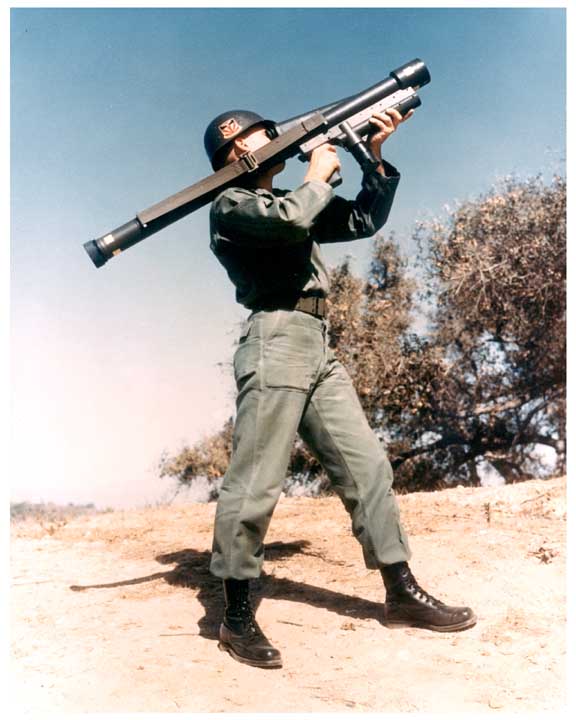
System Chronology
|
May 46 The War Department Equipment Board concluded that the existing .50-caliber machine gun did not have sufficient range or velocity for use against targets of the future. It recommended the development of an antiaircraft machine gun of suitable caliber for use at short ranges, from 200 to 2,500 yards, against targets flying near the ground at speeds up to 1,000 miles per hour (mph). June 48 The U.S. Army Ordnance Corps began work on the STINGER weapon, which consisted of four .60-caliber machine guns mounted on either a towed or self-propelled launcher with an integrated, on-carriage, radar-directed fire control system. 1950 At the Tripartite Conference held in London, England, it was agreed that the U.S. Army's .50-caliber machine gun would be an acceptable weapon for defense against low-flying aircraft from 1950 to 1960, but after that a new system would be required for use against 800-mph airplanes flying at altitudes of up to 1,000 feet. December 50 The new Army Equipment Development Guide, published during this month, stated a requirement for a family of optimum performance weapons and fire control equipment capable of engaging and defeating all enemy aerial vehicles having speeds of up to 1,000 mph, altitudes from ground level to 60,000 feet, and horizontal ranges of up to 27,000 yards. While recommending that the .50-caliber air-cooled machine gun be retained as an infantry weapon on a short-term basis, the review board emphasized the need for a vastly improved low-altitude antiaircraft weapon having a longer range, greater accuracy, and a higher cyclic rate. 1951 Work on the original STINGER weapon was discontinued after the developer determined that the .60-caliber machine guns would not meet the new requirement for an effective slant range of up to 14,000 feet. A 37mm revolver-type gun was built later and tested for possible use with a modified STINGER system, but it proved to be too complex and unreliable, so the project was terminated. 1951 The Army Field Forces (later redesignated the Continental Army Command) established a formal requirement and military characteristics for a surface-to-air guided missile capable of protecting units in forward combat areas from attack by low-altitude aircraft. From these military characteristics evolved the HAWK guided missile system. However, the HAWK system acquired technical characteristics that made it suitable for the division and corps areas only. 1951 Feasibility studies resulted in work on the PORCUPINE, a proposed system for coping with possible attacks on the Continental United States (CONUS) by fighter-bomber planes at altitudes of from 50 to 6,000 feet and ranges between 3,000 and 6,000 feet. A PORCUPINE battery would consist of 64 launching tubes that could fire 2.75-inch rockets at the rate of 6,000 per minute. 1953 Work on Project OCTOPUS began. Work was done on the .50-caliber and .60-caliber mount and 20mm weapon systems. A unique "great circle" mount was developed for tracking along a slant range up to 35 degrees from the horizontal as well as in azimuth and elevation. 1954 In recognition of the increasing threat to combat troops and installations in the forward area, the revised Army Equipment Development Guide restated the requirement for an all-arms antiaircraft weapon to engage low-flying targets from 0 to 1,000 feet. It also recommended that first priority be placed on providing weapons to counter the low-altitude (0 to 10,000 feet) air threat. 1955 Convair, a division of General Dynamics, began feasibility studies of a very lightweight, manportable, low-altitude missile system to fulfill the stated requirement for an all-arms weapon to protect combat and support troops in the battle zone. Preliminary studies indicated that such a weapon was feasible. Intensive technical effort was required to confirm the results of these studies. January 56 Convair engineers, using corporate funds, initiated an 11-month design program to develop their concept for a manportable antiaircraft weapon. Since no military characteristics for such a weapon existed at that time, they formulated a set of design objectives and proceeded to fabricate a functional, full-scale model of the missile. They named the system REDEYE because of its infrared homing device. February 56 The PORCUPINE project was terminated, with no complete system ever being built. 30 November 56 Convair published details of its proposed REDEYE system and made a comprehensive presentation to representatives of the U.S. Army and USMC. Designed to be carried and shoulder-launched by individual field soldiers using a bazooka-type launcher, the proposed REDEYE was 2.75 inches in diameter, 42.75 inches long, and had a gross weight of 14.5 pounds. The launching tube and gripstock weighed 3.7 pounds, giving a total weapon system weight of only 18.2 pounds. The proposed REDEYE used a passive heat-homing guidance system, and for simplicity, the missile was launched directly toward the target. Convair recommended that the system be developed to operational readiness in a three-phase effort. 1957 Project OCTOPUS was cancelled. 10 July 57 The Qualitative Materiel Requirements for the all-arms, low-altitude air defense system, published in the Combat Development Objectives Guide on this date, was built around the alleged capabilities of the proposed REDEYE system. Late 1957 Three defense contractors submitted unsolicited proposals to Redstone Arsenal for an all-arms, manportable weapon to fulfill the requirements set forth in the Combat Development Objectives Guide. In addition to Convair's REDEYE proposal, Redstone Arsenal personnel evaluated Sperry Gyroscope Company's LANCER and North American Aviation's Shoulder-Launched Antiaircraft Missile (SLAM). January 58 The Redstone Arsenal Commander established a REDEYE Section under the Surface-to-Air Missile (SAM) Branch of the Research and Development (R&D) Division. 17 January 58 The Assistant Secretary of the Army authorized a 1-year feasibility study of Convair's REDEYE weapon system, which had been selected by the Redstone Arsenal evaluation team. The Chief of Ordnance also assigned the arsenal national mission responsibilities for the proposed system. 1 April 58 The U.S. Army Rocket and Guided Missile Agency (ARGMA) officially assumed responsibility for the REDEYE project. 14 April 58 Convair/Pomona was awarded a contract for a 1-year feasibility and demonstration of the REDEYE missile system under a program sponsored jointly by the Army and USMC. May 58 Human factors tests were conducted at Twenty-nine Palms and Camp Pendleton, California, using six simulators designed and constructed to simulate the REDEYE weapon as much as possible in weight, balance, appearance, and feel. The objective of these tests was to demonstrate the ability of Army and USMC personnel to detect, acquire, and track typical targets as well as to fire the missile in time to exploit the design capabilities of the weapon. Test results confirmed the soldiers' ability to properly use the weapon and that detection ranges were adequate. June 58 The REDEYE project was officially established with 1A priority, and the scope of the work under the Convair/Pomona contract was expanded to include design and development effort on the rocket motor and airframe. The Marine Corps requested and funded this early development work, while Army funds were confined to the feasibility study and supporting research. 27 June 58 The flight test phase of the feasibility demonstration program began. 10 November 58 In a letter to the Chief of Ordnance, the U.S. Army Ordnance Missile Command (AOMC) Commander recommended that a REDEYE development program be initiated and that the contractor's effort be redirected to best support such a program. 5 April 59 The DA staff, by a Determination and Findings signed on this date, approved the negotiation of a contract with Convair/Pomona (later known as the Pomona Division of General Dynamics) for the Phase II REDEYE development program. However, adequate funding to meet the originally proposed development and production schedule was not provided. 19 February 59 The Secretary of the Army approved military characteristics for the REDEYE. May 59 The Bureau of Ordnance, Department of the Navy, granted permission to the Army Chief of Ordnance for development and production of the REDEYE missile system at General Dynamics' Pomona plant on a non-interference basis and for use of the Naval Ordnance Test Station at China Lake, California, for contractor development tests of the REDEYE. July 59 General Dynamics began full-scale development (FSD) of the REDEYE. As prime contractor, General Dynamics had full responsibility for the overall system design as well as for the production and delivery of a complete REDEYE weapon system capable of meeting the specified military characteristics. March 60 General Dynamics began the REDEYE development flight tests on schedule, but was unable to complete the 260-round program by the December 60 target date because of technical difficulties. These problems resulted in a 3-month slip in the REDEYE development test program. 18 August 60 The REDEYE missile system was classified as Limited Production. September 60 AOMC recommended that the REDEYE industrial effort be deferred until after the missile had been successfully demonstrated against aircraft-type targets and that the initial industrial deliveries be reduced from those originally planned. The proposed alternate plan called for the initiation of industrial action by late December 60 or early January 61, if development firings were successful and no further slippage occurred in the R&D program. 14 October 60 While awaiting action on the alternate production plan, ARGMA released the interim weapon design to production, but deferred the engineering release for procurement until December, when additional demonstration tests were completed. 21 December 60 Because of technical difficulties and large increases in program costs, the Materiel Requirements Review Committee recommended that the FY 61 REDEYE procurement program be cancelled. 30 December 60 DA approved the cancellation of the FY 61 REDEYE procurement program, and the Continental Army Command (CONARC) undertook a study to determine whether or not the program should be initiated in FY 62. 1961 It became apparent from available flight test and laboratory data that the REDEYE system proposed for initial production with FY 62 funds would be unable to meet certain performance requirements. The limitations inherent in the REDEYE were the product of three basic shortcomings: it was not fast enough, it could not maneuver soon enough, and it could not discriminate well enough. April 61 Although still in development; not yet fully qualified for production; and limited in speed, maneuverability, and discrimination capability, the REDEYE was still far superior to any potentially available low-altitude air defense system. Consequently, the AOMC Commander recommended that the version of the REDEYE then under development be produced in those quantities necessary to fulfill priority user requirements. May 61 CONARC and USMC officials acknowledged the shortcomings in the basic REDEYE and agreed to accept on an interim basis a weapon system which did not fully meet all the military characteristics, but which would have effective performance capabilities within its limitations. 18 May 61 A Marine Corps officer conducted the first ejector-only shoulder firings of the REDEYE missile. He suffered no ill effects from noise, recoil, or heat. Several more attempts to fire ejector-only missiles were unsuccessful owing to a malfunction of the battery firing mechanism. 5 June 61 After correction of the deficiency in the firing mechanism, two more ejector-only rounds were shoulder fired. 26 June 61 The Military Requirements Review Committee decided to recommend REDEYE production to DA, subject to the weapon's achievement of a physical target intercept with a shoulder-launched missile. 26 July 61 The first shoulder firing of a ballistic round with both the booster and sustainer motor place occurred during the final support firing. 27 July 61 The first system demonstration shoulder firing of a full-propulsion REDEYE missile was conducted. None of the rounds fired during the system demonstration met the criteria for a successful test. September 61 Approval was granted for a revised program schedule which postponed the industrial effort for another 5 months until technical problems with the REDEYE could be solved. 12 October 61 The REDEYE weapon system made its first public appearance when an Army lieutenant successfully fired the missile during a special weapons demonstration at Fort Bragg, North Carolina. Among those witnessing the demonstration were President John F. Kennedy, Defense Secretary Robert S. McNamara, and Army Secretary Elvis J. Stahr, Jr. 27 October 61 The first complete REDEYE round with a live warhead was shoulder launched on this date, scoring a close miss of 20 feet. 9-10 October 61 The weapon system design presented at the Design Characteristics Review held on this date indicated some minor changes in the physical characteristics of the proposed REDEYE, but not in the basic system concept. 21 December 61 In one of his first official acts as the new Deputy Commanding General (DCG) for Guided Missiles, BG John G. Zierdt prepared a revised program schedule which recommended a general reorientation of the REDEYE development effort, a substantial increase in FY 62 RDTE funds, deferment of REDEYE procurement until FY 63, and a 12-month extension in the Ordnance Readiness Rate. January 62 Higher headquarters approved the reoriented REDEYE development program. 28 June 62 DA renewed the Limited Production classification for the REDEYE. 1 October 62 Following a review of the REDEYE development program, the Director of the Defense R&D Ad Hoc Group on REDEYE concluded that the weapon system was technically feasible, but the magnitude of the development task had been grossly underestimated by the Army and General Dynamics. 19 October 62 DOD concurred with the Ad Hoc Group's assessment of the REDEYE. The system would not be approved for production release until there was a successful system demonstration, and the initial REDEYE procurement was postponed until FY 64. Because of the indicated follow-on of an improved or second generation REDEYE (REDEYE II, later known as STINGER), production build-up on the REDEYE I would be to a minimum sustaining rate of about 1,000 per month only. 14 December 62 REDEYE's first direct hit on a target drone occurred against a 275-knot QF-9F drone flying at an altitude of 1,025 feet. October 63 General Dynamics began the FY 64 product improvement effort. December 63 General Dynamics completed Phase A flight testing of the REDEYE 1 April 64 MICOM established the REDEYE Project Office. 10 April 64 Industrial engineering services and production contracts for the first-year REDEYE buy were awarded to General Dynamics. September 64 New equipment training on the REDEYE weapon system began. FY 65 The REDEYE industrial program experienced serious funding difficulties primarily because of growing Congressional disenchantment with the weapon system. 19 February 65 DA extended the Limited Production classification of the REDEYE system for 2 years. April 65 General Dynamics received the first procurement contract for Block II REDEYE missiles. The tactical Block II weapon system incorporated a number of design changes to improve performance and producibility. July 65 The Advanced Sensor Development Program, which began with the award of a contract to General Dynamics during this month for the Phase I study of a lead selenide/lead bias seeker to give the REDEYE an engagement capability at all aspect angles, paved the way for the improved REDEYE II weapon system. September 65 Delivery of the Block I REDEYE systems began. Completed in May 66, most of the weapons delivered were expended in engineering and service tests. September 65 The integrated engineering/service test program got under way at White Sands Missile Range (WSMR). October 65 General Dynamics received the first contract for the production and delivery of Block III REDEYE weapons. October 65 The objective of the Navy's REDEYE program, Phase I of which began during this month, was to qualify the system for use as a small craft armament. November 65 Except for minor development effort on training equipment, the engineering design phase of the basic REDEYE program was completed during this month, a slippage of 4 years from the original schedule. November 65 Service evaluation tests for the REDEYE started. April 66 Initial deliveries of the Block II REDEYE began. April 66 The engineering evaluation test program, begun in June 64, was completed. 24 May 66 Because the results of service and industrial test firings of Block I production missiles reflected a significant drop in system reliability, the REDEYE Project Manager (PM) halted final assembly of the tactical Block II REDEYE systems effective this date and formed a reliability steering committee to evaluate the test failures and recommend corrective action. 30 June 66 After the steering committee completed its evaluation and positive corrective action was initiated, the stop work order issued on 24 May 66 was lifted. January 67 The integrated engineering/service test program was completed. 10 February 67 An interim release of the REDEYE weapon system for distribution only to the U.S. Army, Pacific (Korea) was authorized to support troop training at Fort Bliss, Texas. 20 February 67 The first REDEYE tactical missiles were released as suitable for issue to the troops. Personnel of the 101st Airborne Division, who were the first to receive gunner training and participate in live Block II firings, were deployed from Fort Campbell, Kentucky, without a full load of equipment. The latter equipment was subsequently withdrawn for redistribution to higher priority claimants in Korea. 15 March 67 In accordance with Southeast Asia Operational Requirement B1, the U.S. Air Force (USAF) undertook the development of a short-range missile system capable of accurate guidance from a maneuvering aircraft against a maneuvering target. Late this same year, the USAF began Phase A of the REDEYE Air-Launched Missile program. After evaluating Phase B of the program, the REDEYE Air-Launched Missile was dropped from consideration because of its operational restrictions in a supersonic launch, program costs, and nonavailability. 29 March 67 DA granted authority to extend the Limited Production classification to cover the fourth production buy. May 67 Block II REDEYE production was stopped so that guided missile test equipment could be converted to Block III. October 67 The REDEYE achieved initial operational capability (IOC) when the first tactical unit was trained, equipped, and ready for deployment. The system was certified for troop use in the temperate zone only pending completion of environmental tests for release of the system for use in extreme climates. 28-29 November 67 User acceptance of the weapon system was confirmed during an in-process review held at AMC. FY 68 During the second quarter, the Block II REDEYE was deployed within the Army. March 68 The deployment of the Block III REDEYE weapons to Europe began on schedule. June 68 Late this month, the helicopter REDEYE Air-Launched Missile program began when General Dynamics was awarded a 12-week contract to determine the feasibility of using the REDEYE as an anti-helicopter and anti-truck system. Although the feasibility of the helicopter REDEYE Air-Launched Missile system was established, this program was eventually terminated. 1 July 68 The urgent need for development of an advanced manportable weapon was expressed and documented in the Technical Review of Army Air Defense Systems Study approved by DA on this date. 29 July 68 The REDEYE Limited Production classification was extended again. September 68 Deliveries of Block III REDEYE weapons began. 19 December 68 The Block III REDEYE was officially reclassified from Limited Production to Standard A. FY 69 The Block II REDEYE weapons originally deployed to Korea were replaced with Block III systems during the year. August 69 The Navy completed its REDEYE program with the delivery of a technical data package describing the Navy weapon. The successful completion of this program qualified the REDEYE for use by the Navy, but there was no firm requirement for procurement of the system. 29 September 69 Block III REDEYE deliveries were completed. 29 January 70 DA approved a Qualitative Materiel Development Objective which outlined the requirement for a follow-on system to the basic REDEYE. Previously, such a system had been designated as the highest priority item in low altitude air defense. 27 April 70 The Secretary of the Army, with AMC's concurrence, removed both the REDEYE and NIKE HERCULES from project management status effective this date. 1971 The REDEYE II was selected for development as a replacement for the basic REDEYE I. 16-17 February 71 During a special Manportable Air Defense System (MANPADS) in-process review held at MICOM, the REDEYE II weapon was evaluated in competition with six other weapons. The review resulted in a recommendation that development of the REDEYE II with identification friend or foe (IFF) and night vision devices begin immediately as a replacement for the basic REDEYE system. April 71 MICOM formed a special REDEYE II Task Team. October 71 The REDEYE II Management Office (Provisional) was established. 5 January 72 The AMC PM for REDEYE II was created at MICOM effective this date. 10 March 72 The REDEYE II was redesignated STINGER. The latter system would replace the basic REDEYE on a one-for-one basis. 27 June 72 The contract for engineering development of the STINGER system was awarded to General Dynamics. April 76 The 82d Airborne Division stated a need for a manpack to airdrop the REDEYE and STINGER as a part of the paratrooper's individual equipment. FY 77 Pursuant to a DA directive, effort began on a plan to transfer REDEYE assets from the Active Army to the U.S. Army National Guard and Reserve units upon replacement of REDEYE by STINGER. April 77 DARCOM (formerly AMC) designated the Natick Research and Development Command as the lead development agency for the REDEYE jump pack. 31 January 78 The Air Defense School at Fort Bliss, Texas, forwarded to the U.S. Army Missile Readiness Command (MIRCOM) a draft proposed letter requirement for the REDEYE jump pack. FY 79 The Army Air Defense School withdrew the draft proposed letter requirement for an airborne jump pack for the REDEYE and STINGER. The jump pack was deemed impractical because both systems were too fragile to withstand the impact of "g" loads without containerization; adding sufficient padding to protect the weapons made the package too cumbersome for a man to carry and jump safely; and an adequate means for air dropping palletized weapons had already been developed. FY 82 Retrograde of the REDEYE missile systems from Europe commenced during the year concurrently with the phased development of the STINGER weapon system. The REDEYE systems were returned to CONUS for redistribution. 16 July 82 MICOM extended the REDEYE missile's shelf life from 18 to 20 years. FY 85 DA directed MICOM to remove all REDEYE missiles from Panama and send them to Hawaii. FY 85 The REDEYE missile shelf life was extended from 20 to 22 years. FY 86 REDEYE system reliability remained high, but sources for secondary items and repair parts for system support to the U.S. Army and foreign military sales (FMS) customers became a major issue. FY 89 The DA decision to phase out REDEYE in FY 94 was pending based on completion of STINGER deployments. FY 90 REDEYE missile retrograde continued as a result of STINGER deployments. REDEYE missiles were used for Army annual service practice (ASP) requirements, while unserviceable, uneconomically repairable (Condition Code P) missiles were used for needed parts unobtainable due to lack of sources. FY 91 The majority of REDEYE activity during the year pertained to the gradual withdrawal and disposal of the weapon system. Due to increasing safety problems related to the system's age, the MICOM community agreed to forward a position to higher headquarters nonconcurring in the extension of REDEYE shelf life beyond 24 years. This position resulted in the discontinuance of REDEYE training, elimination of funding to further extend REDEYE shelf life, and DA direction to withdraw REDEYE missiles upon expiration of shelf life. FY 92 There were no REDEYE repair programs in effect for U.S. assets, although six repair programs from FMS customers were in process at Tooele Army Depot, Utah. FY 95 All REDEYE missiles at Tooele Army Depot were in the process of being demilitarized. |
REDEYE Photos
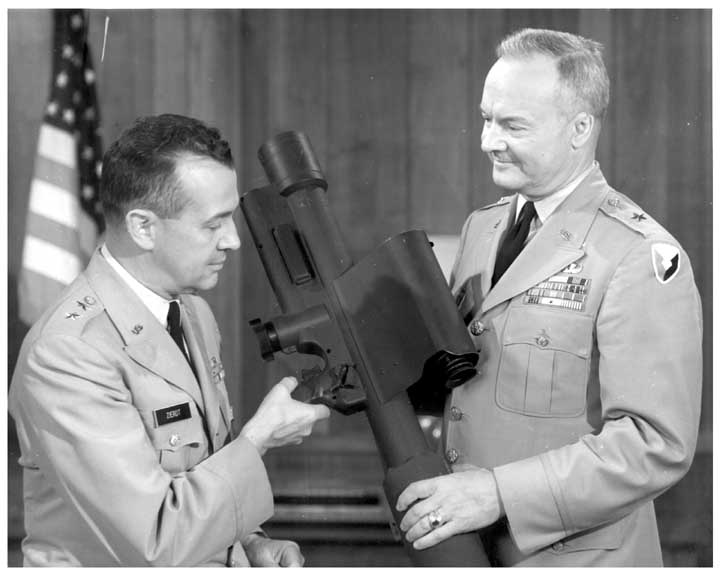 |
 |
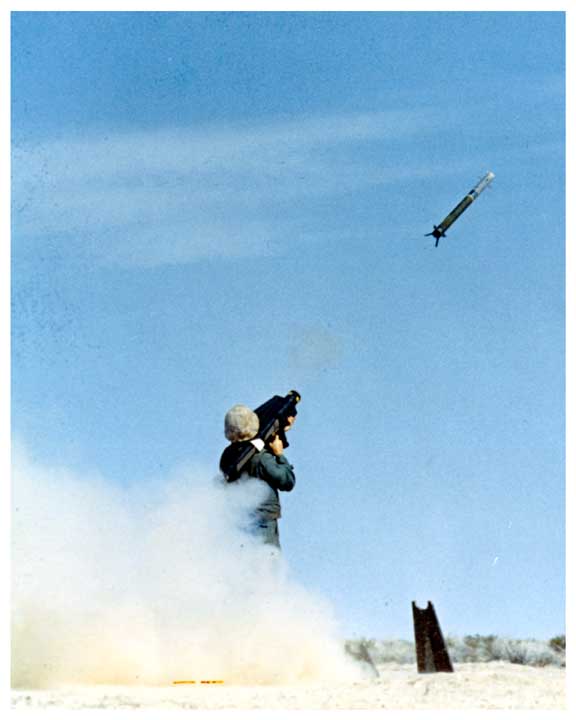 |
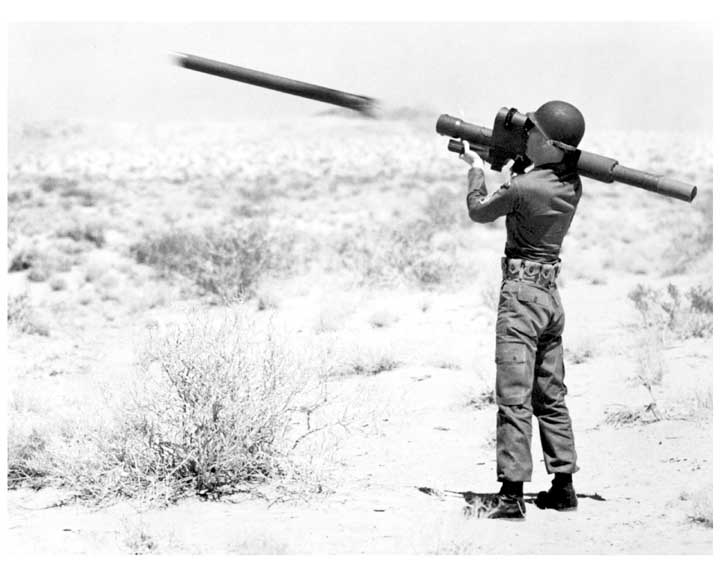 |
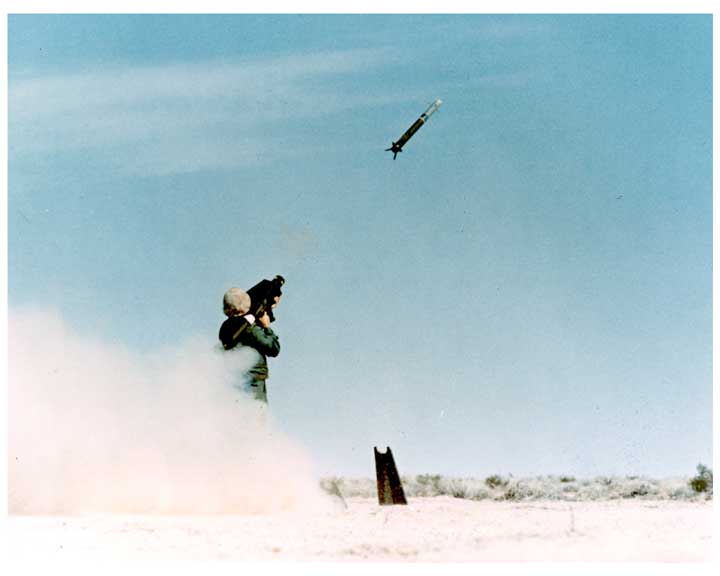 |
 |
